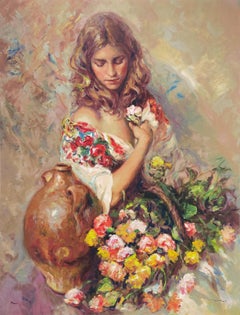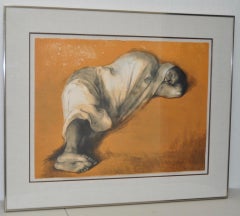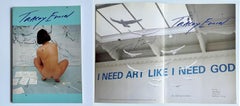Clay Figurative Prints
to
3
4
4
1
2
1
Overall Height
to
Overall Width
to
3
1
3
3
3
1
1
4
1
2
3
1
4,462
13,842
10,872
6,341
3,181
Medium: Clay
SENTIMIENTO
By José Royo
Located in Aventura, FL
Serigraph on clay board panel. Hand signed and numbered by the artist. Edition of 240.
Artwork is in excellent condition. Certificate of authenticity included. All reasonable offer...
Category
1990s Impressionist Clay Figurative Prints
Materials
Clay, Board, Screen
SOL Y SOMBRA
By José Royo
Located in Aventura, FL
Serigraph on clayboard panel. Hand signed and numbered by the artist. Edition PA of 14.
Artwork is in excellent condition. Certificate of authenticity included. All reasonable offe...
Category
1990s Impressionist Clay Figurative Prints
Materials
Board, Screen, Clay
INVIERNO
By José Royo
Located in Aventura, FL
Serigraph on clayboard panel. Hand signed and numbered by the artist. Edition PA of 15.
Artwork is in excellent condition. Certificate of authenticity included. All reasonable offer...
Category
20th Century Impressionist Clay Figurative Prints
Materials
Panel, Board, Screen, Clay
Pablo Picasso, Fluffy-haired Woman, clay plaque
Located in Chatsworth, CA
This piece is a rectangular red earthenware clay plaque, printed with engobe pad in black, created by Pablo Picasso in 1964. This piece is numbered from th...
Category
1960s Surrealist Clay Figurative Prints
Materials
Clay
Related Items
Soledad Acostada
Located in San Francisco, CA
Pencil signed lithograph by Costa Rican Master Francisco Zuniga (1921-1998)
Works by Zuniga are instantly recognizable. He is mostly known for his paintings of rural indigenous wome...
Category
Mid-20th Century Impressionist Clay Figurative Prints
Materials
Lithograph
Monograph: I Need Art Like I Need God (Hand signed by Tracey Emin)
By Tracey Emin
Located in New York, NY
Tracey Emin
I Need Art Like I Need God (Hand signed by Tracey Emin), 1998
Softback monograph with stiff wraps (Hand signed by Tracey Emin)
Hand signed in black ink by Tracey Emin on ...
Category
1990s Pop Art Clay Figurative Prints
Materials
Paper, Offset, Lithograph, Mixed Media, Ink
H 11.75 in W 8.5 in D 0.5 in
Active Shooter
Located in Palm Springs, CA
A Lone Ranger cowboy at night.
Medium: Aquatint, Drypoint, Etching
Year: 2018
Image Size: 12 x 12 inches
Edition Size: 75
Lawlor's early etchings were often landscapes combining ...
Category
2010s Impressionist Clay Figurative Prints
Materials
Etching, Aquatint
Domergue - Sublime - Original Signed Lithograph
Located in Collonge Bellerive, Geneve, CH
Original Lithograph by Jean-Gabriel Domergue
Title: Sublime
Signed in the plate
Dimensions: 40 x 31 cm
1956
Edition of 197
This artwork is part of the famous portfolio "La Parisienne...
Category
1950s Impressionist Clay Figurative Prints
Materials
Lithograph
H 15.75 in W 12.21 in D 0.04 in
Dans les Cendres (In the embers)
Located in Storrs, CT
Dans les Cendres (In the embers). 1887. Delteil catalog 67 state iii. State after the plate was cut down and a second figure eliminated (the two earlier states are of the greatest rarity). Etching, drypoint and roulette. 16 3/4 x 12 1/8 (sheet 19 1/2 x 14). Edition 50. Illustrated: Print Collector's Quarterly 9 (1921): 254. A very rich impression with plate tone and drypoint burr, printed on simili-japon. Provenance: Frederick Keppel & Co. This is one of the artist's most striking images. Signed in pencil. Housed in 25 x 20-inch archival mat, suitable for framing.
Paul Albert Besnard, was an impressionist painter. In 1866, the seventeen-year-old son of artist parents began his studies at the École des Beaux-Arts Paris. In 1874, Besnard won the important Prix de Rome, with which the academy distinguished young talent. A portion of the scholarship is a stay of several years in Rome. Besnard married Charlotte Dubray, a sculptress, during this time in Rome. The couple lived in England, where Besnard exhibited at the Royal Academy London, between 1881 and 1884. He became involved with English portrait painting during this period, which had a lasting influence on his work.
In the years that followed, Besnard broke with the academic tradition. In 1886, he presented the portrait of Madame Roger Jourdain...
Category
Late 19th Century Impressionist Clay Figurative Prints
Materials
Drypoint, Etching
Domergue - Elegance - Original Signed Lithograph
Located in Collonge Bellerive, Geneve, CH
Original Lithograph by Jean-Gabriel Domergue
Title: Elegance
Signed in the plate
Dimensions: 40 x 31 cm
1956
Edition of 197
This artwork is part of the famous portfolio "La Parisienne"
Category
1950s Impressionist Clay Figurative Prints
Materials
Lithograph
H 15.75 in W 12.21 in D 0.04 in
Vitraux pour Jérusalem - Illustrated Book by M. Chagall, 1962
By Marc Chagall
Located in Roma, IT
"Vitraux pour Jerusalem" is one of the most important books illustrated by Marc Chagall and considered as one of his editorial masterpieces.
Th...
Category
1960s Surrealist Clay Figurative Prints
Materials
Paper, Lithograph
H 11.03 in W 14.18 in D 1.19 in
Domergue - Dark Hair Lady with a Scarf - Original Signed Lithograph
Located in Collonge Bellerive, Geneve, CH
Original Lithograph by Jean-Gabriel Domergue
Title: Dark Hair Lady with a Scarf
Signed
Dimensions: 40 x 31 cm
1956
Edition of 197
This artwork is part of the famous portfolio "La P...
Category
1950s Impressionist Clay Figurative Prints
Materials
Lithograph
H 15.75 in W 12.21 in D 0.04 in
Le Jongleur (The Minstrel)
Located in Storrs, CT
Le Jongleur (The Minstrel). 1930. Etching and aquatint printed in colours. Chapon/Rouault 199 d. 12 1/4 x 8 1/2 (sheet 17 1/4 x 13 1/8). Series: Cirque plate 2. Edition 270. Initial...
Category
Early 20th Century Impressionist Clay Figurative Prints
Materials
Color, Aquatint
Madame Helleu Looking at Watteau drawings at the Louvre..
Located in Storrs, CT
Madame Helleu Looking at Watteau drawings at the Louvre. (En regardant les Watteau de Louvre). c. 1895. Drypoint printed in 2 colors - black and sepia. 11 3/4 x 15 7/8. Goncourt 3, d...
Category
Late 19th Century Impressionist Clay Figurative Prints
Materials
Drypoint, Color
H 20 in W 14.5 in D 2 in
Flowers, (After) Andy Warhol -Pop Art, Tapestry, Edition, Contemporary, Design
By Andy Warhol
Located in Zug, CH
(After) Andy Warhol
Flowers, 1968
Hand Woven Wool Tapestry
183 x 183 cm (72 x 72 in)
Edition of 20
With the knotted name ‘ANDY WARHOL’ lower right and the embroidered annotation ‘WARHOL ©’ on the reverse
Published by Modern Master Tapestries, NY
Throughout art history, the flower and its symbolism have been a subject matter for many renowned artists. Andy Warhol explored the qualities of the flower image through his Pop Art prism in the Flower series of 1964, thus creating cartoon-like symbols that would be instantly recognized.
The 1964 Flower series became one of his most iconic and successful works. Based on a discovered photograph of hibiscus blossoms, Warhol drenched the flowers’ floppy shapes with a variation of vibrant colors, transforming them into psychedelic indoor décor. Playing with traditional art historical themes, Andy Warhol gave a particular twist to this historically accepted symbol of life. The electric colors of his flowers, drawn from a darker and rich undergrowth background might be the indicator of an extreme vision of life, a life lived on the edge.
Andy Warhol (1928-1987) was an American artist, a leading figure of the Pop Art movement. Using a variety of media materials from photographs up to computer-generated art, Warhol's works explore the relationship between artistic expression, celebrity, culture and advertisement that flourished by the 1960s. Emerging from the poverty and obscurity of an Eastern European immigrant family in Pittsburgh, Warhol became a charismatic magnet for bohemian New York. In 1960, he began to produce his first canvases depicting Popeye and Dick Tracy. After Marilyn Monroe’s death in August 1962, he started working from snapshots of the star’s already legendary face, which had been widely distributed by the world’s press. His choice of subjects clearly relates to an obsession with demise – his Marilyns, his Ten Lizies (created when the actress Elizabeth Taylor was seriously ill), and also his Elvis. Part of the “Death and Disaster” series, Andy Warhol´s...
Category
20th Century Pop Art Clay Figurative Prints
Materials
Tapestry, Wool
H 72.05 in W 72.05 in D 1.19 in
Things to Come tray
Located in New York, NY
Herbert Bayer
Things to Come tray, 2018
Porcelain dish with metallic gold edge and silkscreened image
Limited edition of an unknown quantity, originally distributed by the Museum of Modern Art, before it sold out.
Measurements:
Box:
5.5 x 5.5 inches
Tray:
5 x 5 inches
Provenance:
Originally distributed by the Museum of Modern Art, before it sold out
Manufacturer:
Galison Publishing LLC and The Museum of Modern Art
Herbert Bayer biography:
Artistic polymath Herbert Bayer was one of the Bauhaus’s most influential students, teachers, and proponents, advocating the integration of all arts throughout his career. Bayer began his studies as an architect in 1919 in Darmstadt. From 1921 to 1923 he attended the Bauhaus in Weimar, studying mural painting with Vasily Kandinsky and typography, creating the Universal alphabet, a typeface consisting of only lowercase letters that would become the signature font of the Bauhaus. Bayer returned to the Bauhaus from 1925 to 1928 (moving in 1926 to Dessau, its second location), working as a teacher of advertising, design, and typography, integrating photographs into graphic compositions.
He began making his own photographs in 1928, after leaving the Bauhaus; however, in his years as a teacher the school was a fertile ground for the New Vision photography passionately promoted by his close colleague László Moholy-Nagy, Moholy-Nagy’s students, and his Bauhaus publication Malerei, Photographie, Film (Painting, photography, film). Most of Bayer’s photographs come from the decade 1928–38, when he was based in Berlin working as a commercial artist. They represent his broad approach to art, including graphic views of architecture and carefully crafted montages.
In 1938 Bayer emigrated to the United States with an invitation from Alfred H. Barr, Jr., founding director of The Museum of Modern Art, to apply his theories of display to the installation of the exhibition Bauhaus: 1919–28 (1938) at MoMA. Bayer developed this role through close collaboration with Edward Steichen, head of the young Department of Photography, designing the show Road to Victory (1942), which would set the course for Steichen’s influential approach to photography exhibition. Bayer remained in America working as a graphic designer for the remainder of his career.
-Courtesy of MOMA
More about Herbert Bayer:
Herbert Bayer (1900-1985) was born in Austria, where he entered into an apprenticeship under the architect and designer, Georg Smidthammer, with whom Bayer learned drawing, painting, and architectural drafting, inspired by nature and without formal knowledge of art history. In 1920, Bayer discovered the theoretical writings of the artist Vassily Kandinsky, as well as Walter Gropius’ 1919 Bauhaus manifesto, in which Gropius declared the necessity for a return to crafts, in which were found true creativity and inspiration. Bayer traveled to Weimar to meet Gropius in October of 1921 and was immediately accepted into the Bauhaus. There, he was deeply influenced by the instruction of Kandinsky, Johannes Itten and Paul Klee.
In 1928 Bayer moved to Berlin together with several members of the Bauhaus staff including Gropius, Moholy-Nagy and Marcel Breuer. He found work as a freelance graphic designer, particularly with German Vogue, under its art director Agha. When the latter returned to Paris, Bayer joined the staff full time, and also worked increasingly with Dorland, the magazine's principle advertising agency. It was in the period from 1928 to his emigration to America in 1938 that he developed his unique vision as an artist, combining a strongly modernist aesthetic sense with a rare ability to convey meaning clearly and directly. This seamless combination of art, craft and design mark Bayer as true prophet of Bauhaus theories.
Bayer followed Gropius to America in 1938, and set his breadth of skills to work later that year in designing the landmark Bauhaus 1918-1928 exhibition at the Museum of Modern Art. Bayer flourished in New York as a designer and architect, but it was his meeting with the industrialist Walter Paepcke in 1946 that allowed him to harness his concepts of 'total design' to the postwar boom. Paepcke was developing Aspen as a cultural and intellectual destination, and found in Bayer the perfect collaborator. Bayer was designer, educator and indeed architect for Paepcke's Aspen Institute...
Category
2010s Bauhaus Clay Figurative Prints
Materials
Metal
Clay figurative prints for sale on 1stDibs.
Find a wide variety of authentic Clay figurative prints available on 1stDibs. While artists have worked in this medium across a range of time periods, art made with this material during the 20th Century is especially popular. There are many well-known artists whose body of work includes ceramic sculptures. Popular artists on 1stDibs associated with pieces like this include José Royo, and Pablo Picasso. Frequently made by artists working in the Impressionist, Surrealist, all of these pieces for sale are unique and many will draw the attention of guests in your home. Not every interior allows for large Clay figurative prints, so small editions measuring 0.04 inches across are also available




